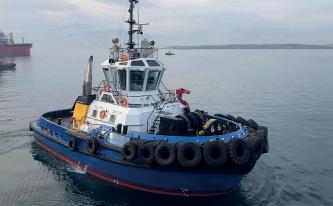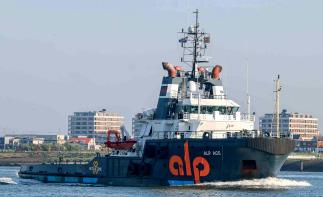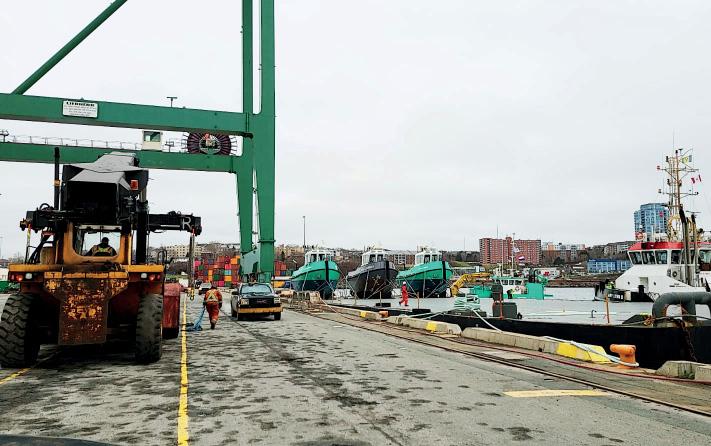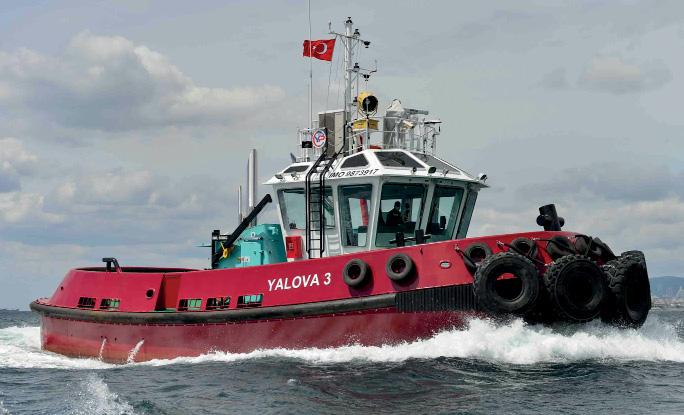
20 minute read
Salvage conference
SALVAGE AND WRECK REMOVAL CONFERENCE
The annual Salvage and Wreck Removal Conference has taken place with salvage, insurance and legal communities reported to be ‘focused together on this important industry’
The conference, organised by Informa PLC and supported by the International Salvage Union (ISU) is traditionally held in London but due to the Covid-19 situation was on this occasion held virtually with speakers and panel sessions available live also recorded for later viewing. Participants were also able to connect with each other through their own systems.
The salvage industry has in the past emphasized the principle, use it or lose it and in his opening address, ISU president Richard Janssen referred to earlier conferences where panel discussions were held on the subject of capacity stating: ‘... it is now an open question whether the capacity of the industry is satisfactory and whether its capability is aligned with the risks run by underwriters.’ Talking of times gone by, he added: ‘We need to recognise that there is no place for romantic or heroic stories about how things used to be, nor for old fashioned prejudice and characterisation of salvage professionals. Only through continued dialogue about today’s and tomorrow’s challenges and the basis on which salvage services are being remunerated can we ensure - as underwriters and salvors - that we continue to serve our mutual principal, the shipowner.’
Referring to low levels of LOF cases and revenue Mr Janssen stated: ‘It is interesting to see the clubs also recognising the value of LOF, facilitating as it does, rapid intervention which can prevent a casualty from becoming a costly disaster.’ He concluded that it is not difficult to make a strong case for the professional marine salvor operating with their own equipment and focussed on reducing business interruption of a shipowner and limiting their exposures and that of their underwriters.
This theme was explored by Lloyd’s Appeal Arbitrator, Jeremy Russell QC describing the assessment of salvage awards as an ‘art not a science’ where awards should strike a balance between competing interests and be fair remembering that Article 13 of the Salvage Convention requires that rewards should be fixed with a view to encouraging salvage operations. Mr Russell stated that if there were concerns that awards were too generous, it should be remembered that only through generous awards could salvors hope to recoup losses for abortive sorties, cases where there was no pay and no reward and cases where the salvor was unable to obtain security.
Rahul Khanna of Allianz provided a round-up of casualty statistics reporting that the 41 total losses in 2019 was a record low with South China, Indonesia and the Philippines the worst regions for total losses but the British Isles, North Sea, English Channel and Bay of Biscay becoming worst regions for casualties with 605 incidents. Car carriers, roro vessels and containership fires are the major concern.
The demise of Ardent in 2020 took many by surprise and the topic was considered by a conference panel with Mr Janssen commenting: ‘the market is always right and salvors need to adapt’. Speaking as president of the American Salvage Association, Resolve Marine’s Lindsay Malen Habib said that the stringent equipment and speed-of-reaction requirements of the US salvage and marine firefighting requirements of OPA 90 meant providers needed to invest in assets but that previously pricing for providing these services was unsustainable. She suggested it was unlikely that there would be new major players entering the US Market.
Piraeus-based Tsavliris Salvage is one of the best known global marine emergency response contracting companies, a particularly frequent user of LOF contracts. Its activities are recounted regularly in MJ and ISU reports that George Tsavliris gave a passionate speech about the industry in which he has more than 50 years’ experience and the importance of moving forwards and remaining optimistic.
Ben Harris, claims director for Shipowners P&I Club summed up saying: ‘In emergency response, insurers wanted a viable industry ready to respond without delay; salvage capacity with resilience and investment and training.’ He stated that in wreck removal insurers want a competitive market and an appetite for commercial risk adding that Clubs want to be more involved at the front of the process stating: ‘We want to make sure there is response when required.’

8 P&I Clubs are
calling for a ’competitive’ wreck removal market
8 Salvage awards
are fi xed with a view to encouraging salvage operations
Credit: Tsavliris Salvage
TUG DELIVERY AND ORDER ROUND-UP
We look at just three tug deliveries from Sanmar and Damen this month along with a notable order for a new vessel for Svitzer on the river Thames.
Sanmar’s 2018 built Boğaçay XXXIII has joined the fleet of Eren Holdings, a Turkish company with a wide range of business interests including Eren Port on Turkey’s Black Sea coast. The tug is a Robert Allan Ltd Ramparts 2400 design and with a LOA of just 24m provides a respectable 60tbp from twin 1,765kW main engines. It is Eren Energy’s third Sanmar-built tug and features class 1 fire-fighting capability.
Bermuda is a popular destination for cruise ships but an increase in vessels of all types has meant the port’s two shiphandling tugs, which have provided sterling service for 30-odd years, no longer provided adequate power and have been replaced by a more powerful pair, their funding reportedly helped by a berthing agreement up to 2028 with Norwegian Cruise Line. Bermuda’s Department of Marine and Ports turned to Damen for the new vessels and recently the ASD Tug 2811s Faithful and Powerful were with Svitzer now the dominant operator. Developments on the river including DP World’s London Gateway container terminal have seen an increase in both numbers and size of ships with Kotug Smit, now part of Boluda also providing towing services on the river
Svitzer has now upped the game with an order for a Damen ASD Tug 3212. The 80tbp Svitzer Thames will enter service immediately upon arrival by the end of Q1 2021 with Lise Demant, managing director for Svitzer Europe commenting: “Svitzer Thames is a particularly welcome addition to our London fleet, enabling us to upgrade and improve our already excellent service in one of Europe’s most crucial ports.”

8 Bogacay XXXIII will be Eren Energy’s third
Sanmar-built tug
Credit: Sanmar
delivered to their new home from Damen’s Song Cam Shipyard in Vietnam.
They are examples of Damen’s ‘next generation’ tugs and deliver 60.6tbp and speed 13.6kn from Caterpillar main engines and Kongsberg thrusters. Towing is over the bow via a 150t brake two-speed split drum winch and the fifi1 classed pair have accommodation for seven persons in three single and two double-berth cabins.
Over recent years towing provision on London’s river Thames has seen an increase in competition, traditional long-established companies being taken over by larger entities

8 Svitzer will enhance its London operation with
arrival of Svitzer Thames
“We got 59,115 hours on those engines without even removing a head”. For Seaspan International however, re-engining the 47-year-old tug Seaspan Cavalier was a worthwhile investment.
Seaspan’s port engineer Kevin Tweedy adds “and they could easily have done 60,000 hours” providing an insight into the project to give a new lease of life to the vessel in an operation common for example in Europe where re-engined and re-built tugs of 50 years vintage are not unusual in certain sectors.
Seaspan Cavalier was built in 1974 at the company’s own shipyard, one of four similar tugs towing fuel and general cargo barges on the British Columbia coast, often involving triple wood-chip barges. The vessel is no stranger to such surgery however having been re-engined twice before, hinting at the hours these workhorses put in.
Mr Tweedy explains the process: “We cut a seven by eight-foot hole in the tug’s port side and installed both starboard and port engines through that” adding that the same place is used each time with the old welds being cut in both the hull plate and framing ensuring the structural integrity of the hull. He explains further: “Putting it back together we do a sealing weld from the inside first, then clean the weld from the outside before doing a second sealing weld from the outside.”
The old 850hp, Tier I, Cummins KTA38 main engines were replaced by brand new Tier II versions of the same engine clearly demonstrating faith in the original arrangement. The engines are coupled to the ‘massive and virtually indestructible’ Lutkin hold-down claw also fitted and the tug was expected to maintain its 27tbp, the transition from Tier I to Tier II requiring minor popping and electrical modifications. Mr Tweedy sums up the project saying: “We don’t expect any problems and the Cummins guys are good. They take care of us.”
NEW ENGINES FOR TUG NEARLY FIFTY YEARS OLD

RLS 3614 gearboxes turning three-bladed propellers in nozzles. “The props are in good shape” says Mr Tweedy adding: “but we will send them to Osborn Propellers for tune up, crack testing and pitch tests as well as weld fill in way of cavitation and balancing.”
Seaspan Cavalier is fitted with a singledrum Burrard Iron Works winch spooled with 548m of steel wire rope, tow pins and a
8 47-year old Seaspan Cavalier has received its
third re-engining
The Netherlands Coast Guard has increased its emergency towing provision in the North Sea with a powerful tug to guard the Borssele off shore windfarm.
Since 1 January this year the tug ALP Ace, owned by ALP Maritime Services and operated by Terneuzen-based Multraship is providing towing stand-by services at the windfarm on a temporary basis until a more permanent vessel takes up the role for a ten-year period. Contract management is provided by Rijksrederij who manages specialist ships including customs, Ministry of Agriculture and Coast Guard vessels.
With increasing numbers of offshore windfarms in the North Sea there is natural concern of the consequences of a ship losing propulsion and drifting into the site before contracted towage assistance arrives. The windfarm, off the Zeeland coast is the largest offshore windfarm in the Dutch part of the North Sea and in an area with a lot of shipping activity due to the proximity of nearby ports of Antwerp and Rotterdam. As well as its primary ETV duties, ALP Ace is also available for other Coast Guard taskings including SAR operations.
A shipping corridor has been included in the Borssele windfarm for ships up to 45m in length to pass under certain conditions and accommodating 1,600m of 76mm wire along with an additional 1,200m storage reel.
This deployment brings the number of dedicated ETVs under Dutch control to two. Further north, Multraship also operates the Italian-owned tug supply vessel Guardian V (previously Ievoli Amaranth) which is based at Den Helder.
Another well-equipped vessel, Guardian was built in Turkey in 2013 and of 65.7m length on a breadth of 15.5m. It is also of conventional design powered by MAK main engines developing 8,000kW total.

Damen Shipyards recently took advantage of a unique opportunity to deliver a fi ve-vessel order to three separate customers in Canada.
Transporting tugs piggy-back on heavylift vessels from the builder to their eventual destination is not new and Damen recently adapted this model when five vessels were required by Canadian clients involving a newbuild pontoon carrying three Stan Tugs, towed by a former Damen Marine Services’ (DMS) chartered Shoalbuster.
The story began with Ontario-based Doornekamp Construction’s contract with Damen for a Shoalbuster 3209. The 2013-built tug formerly part of DMS’s charter fleet was renamed Amy Lynn D with the requirement to be delivered to Canada, the sale was however just the beginning of a larger delivery project.
Shortly after this initial deal Doornekamp placed a follow-up order for a Stan Pontoon 7524 so it made sense for Amy Lynn D to tow the barge to their new home in Canada. Before setting out however, with the assistance of ACL Shipbrokers, Damen secured an order for three Stan Tug 1205s for two customers also in Canada, the foundations were now there for a costeffective means of delivery for all five vessels, the three Stan Tugs loaded on the barge.
The only access to the St Lawrence Seaway was via Montreal locks which closed annually between Christmas and April so with time of the essence another Shoalbuster was chartered from Van Wijngaarden Marine Services to tow the barge loaded with the Stan Tugs to Algeciras to meet up with Amy Lynn D. Finally, after a voyage of 4,700NM the
ADDITIONAL EMERGENCY TUG FOR DUTCH WATERS
8 Alp Ace will be operated by Multraship as a
second Dutch ETV
Credit: Peter Barker
Rijkwaterstaat is to carry out a monitoring and research programme over the next ten years to examine effects of the security measures including supervision and enforcement by the Coast Guard and the ETV deployment.
ALP Ace, built in 2006 in Germany is a regular site in north-west Europe. Powered by MAN main engines (14,000kW total) driving CP propellers the 58.5m LOA tug is of conventional design with an electrically driven twin drum towing winch aft, each drum
COMPLEX TUGS AND BARGE DELIVERY FOR DAMEN

first two Stan Tugs were delivered to client Dominion in Halifax, and the second to Montreal all before Christmas. Amy Lynn D and barge passed through the locks in the direction of Picton, Ontario for Doornekamp Construction just one week before Christmas.
Damen sales manager Juriaan Daams described the operation as: ‘An interesting process and one that demonstrates the synergy within the Damen Shipyards Group...
8 Three Stan Tug 1205s were delivered aboard a
Stan Pontoon 7524 all to Canada
applying the synergy within our organisation we were able to get everything done in-house.’ The commercial process was assisted by Damen Trading with the barge docked at Keppel Verolme in Rotterdam and the Shoalbuster at Albwardy Damen in Sharjah while the Stan Tugs were at Damen Shipyard Hardinxveld around 20km inland from Rotterdam.
The UK Maritime and Coastguard Agency (MCA) has issued a General Exemption to remedy an ‘administrative irregularity’ concerning certifi cation of workboats.
Marine Information Note 619 (M) relates to MCA Codes of Practice published in 1998 and 2018 where the Workboat Code Edition 2 and the Technical Annex incorrectly purported to expand the scope of the definition of a small vessel to also include ‘a vessel the keel of which was laid or was at a similar stage of construction before 21 July 1968, less than 150 tons’.
The specific codes are ‘The Safety of Small Workboats and Pilot Boats - A Code of Practice’, also known as the Brown Code and now referred to as Workboat Code Edition 1 dated 1998 and the updated standard known as Edition 2 issued in 2018, this later version including the equivalent standard published in the Technical Annex to Marine Guidance Note MGN 280 (M) as far as that document applies to small workboats and pilot boats.
A small number of vessels built before that date and 24m or more in length, but less than 150 tons have been incorrectly issued with workboat certificates; these vessels fall outside the scope of the 1998 regulations and the MCA has issued the General Exemption to remedy
Following Sanmar’s discontinuation of the tug marque bearing the same name Robert Allan Ltd (RAL) has described further the replacement in its RApport 1900SX harbour tug.
Last year, Sanmar Shipyards announced its ‘out with the old, in with the new’ plans to discontinue the Ulupinar, Doğançay and Sanmar tug series but with continuity maintained by RAL’s RAscal 1800, RAmparts 2200 and RApport 1900SX models and it is this last example that RAL has described in detail, replacing the Sanmar class 31 of which have been built since 1995.
Harbour and coastal tug deliveries are dominated nowadays by powerful ASD or tractor configuration vessels employing azimuth or cycloidal drives, so it is easy to overlook demand for high performance conventional in-line shaft and propeller designs produced at a competitive cost and capable of coastal tows as well as harbour assistance. These requirements fit the bill with the RApport 1900SX designated the Bozçay class by Sanmar.
An increased beam of 8m (moulded) on a LOA of 19.3m provides improved stability, wheelhouse visibility described as ‘excellent in all directions.’ Conventional twin-screw propulsion and twin high-aspect ratio rudders behind each propeller produce 33tbp from twin Caterpillar C32 main engines producing 1,940kW in total and connected to ZF 3761 6:1 reverse/reduction gears and 175mm shafts turning 1,880mm four-bladed propellers in nozzles. The engines are supplied with dry exhausts and polished stainless steel tail pipes.
MCA CORRECTS IRREGULARITY IN WORKBOAT RULES

Credit: Peter Barker
8 Workboats have evolved into sophisticated
and powerful vessels in recent years
the position and facilitate regulatory compliance for the affected vessels. Detailed conditions to be met for the exemptions are contained in an annex to the note (MIN 619 (M).
The document notes that the General Exemption is granted on the basis that the affected vessels fall outside of the 1966 International Load Line Convention (as amended) implemented by the associated 2018 Merchant Shipping Regulations. The MCA presently considers the General Exemption a temporary solution while work is undertaken to bring the affected vessels within the scope of the statutory certification scheme.
Notwithstanding that the exemption is down to an administrative irregularity, the topic recalls the development of workboats around 1968. Modern shallow draught Multi Cat type workboats are particularly common nowadays, sophisticated vessels with notable towing capabilities along with heavylift deck cranes. Prior to this period however such vessels were often derived from conventionally shaped hull designs, perhaps retired tugs where the relationship between vessel length and gross tonnage was somewhat different to today’s workboats.
KEEPING FAITH WITH SANMAR CLASS REPLACEMENT

A 45t tow hook is fitted aft with an electric or hydraulic towing winch available as option. Fendering can be adapted to client requirements, the standard fit being 300mm ‘D’ fenders at the sheer and vertical ‘W’ fenders around the bow including provision of a push knee if required. The mast can be of folding type if required and a large shipping hatch is located between the funnels providing a removal route for large items of machinery including an entire main engine. Overnight
8 Sanmar’s latest design promises to be an
effi cient conventional drive workhorse
accommodation is provided forward for a crew of four in two cabins with the option of a three-cabin arrangement for a crew of five.
Six examples of the Bozçay class are already in service with Sanmar and Marintug in the Gulf of Izmit and Antalya Port in Turkey and this handy-sized conventional tug will no doubt follow the tradition of large numbers series production by Sanmar.
8 The port of Zeebrugge has welcomed two
new tugs with arrival of VB Bolero and VB Rumba for Boluda Towage Europe.
The Damen ASD 2813 vessels, examples of Damen’s “next generation” tugs provide 85tbp via Tier III compliant engines equipped with Damen’s NOX reduction system. They are part of Boluda’s extended towage concession at Zeebrugge and the pair arrived recently from nearby Rotterdam where they were unloaded from the heavylift vessel Frauke after their delivery voyage from Damen’s Song Cam Shipyard in Vietnam.
8 On the other side of the world, another port
welcoming new arrivals is Port Geraldton in Western Australia in the tugs Svitzer North and Svitzer Abrolhos, the fi rst two of a three vessel order.
The ASL Shipyard-built RAL RAstar 3000-W ASDs have a bollard pull of 71t and will enhance shiphandling provision in the port which handles over 400 ship visits per year, the main cargo being iron ore. They feature Caterpillar machinery and Schottel thrusters with an Ibercisa double-drum escort winch forward. The third vessel Svitzer Wilu is currently under construction and due to join its predecessors shortly. 8 As part of its strategic development,
Norwegian contractor BOA Off shore has sold its subsidiary company Trond A. Kittelsen Shipping AS.
The sale includes the 36tbp tug Boa Sund, built in Germany in 1976 as Johanna and two flat-top barges Boabarge 49 and Boabarge 31 along with the rock barge Takboa, the sale also including part ownership of the 400t-lift floating crane Taklift. The assets are to be renamed and the announcement made no mention of the vessels’ new owners.

8 Author Henk Hensen has found a new
publisher for three of the industry’s most authoritative and respected books after the previous publisher went into administration.
The towing world is poorer with demise of The ABR Company Ltd and its popular ITS and Tugnology conferences. It also published Mr Hensen’s books Tug use in port, Bow Tug
8 VB Bolero and VB Rumbavare the latest arrivals
at Zeebrugge
Operations and Tug Stability and having retrieved the print files and stock books from administrators has started with a new publisher in the Netherlands. The titles can be obtained from www.stc-publishing.nl email info@stc-publishing.nl with a restart discount of 20% offered until 1 April 2021. These informative guides can be rightly considered a must-read for both new and old members of the towing community.
FORTH PORTS ACQUIRES TARGE TOWING
Forth Ports Ltd and Targe Towing Ltd have jointly announced that Forth Ports has acquired the entire share capital of Targe Towing.
Continuing what has been a theme of consolidation within the industry this latest development involves Forth Ports taking over Targe’s fleet of nine vessels including five tugs operating on the Scottish east coast along with a further three operating at Hound Point marine terminal on the Firth of Forth. Forth Ports operates 10 vessels including four tugs.
Targe Towing along with Forth Ports’ towing subsidiary Forth Estuary Towage have had a long-running close working relationship, both companies believing the acquisition ‘represents an opportunity to build on Targe’s reputation, to expand and take advantage of business opportunities in the towage and marine services area.
Targe was formed by Tom Woolley in 1991 and along with operations director Nick Dorman continues to lead the business with day-to-day operations remaining the same and the Targe name being retained. Alasdair Smith, Forth Ports’ senior marine commercial Ports’ chief operating officer. The consideration for the acquisition has not been revealed.
Targe is a well-respected towage contractor in the region having received awards for its work at Hound Point from BP and INEOS, both major customers of Forth Ports and Targe.
Tom Woolley, Targe Towing managing director said: ‘We have enjoyed a close working relationship with the Forth Ports team for years and it’s clear that there are opportunities that we can pursue together to further develop the business.’
Targe’s fleet of tugs include three modern 70tbp Sanmar-built RAmparts 2400SX vessels, Kittiwake, Peterel and Queensferry all delivered in the last three years. Other vessels of note include the Spanish-built Dalmeny and Hopetoun, the latter of which when delivered in 1997 with a bollard pull of 124t was reported as the most powerful of its type in the world. Another vessel worthy of mention is the 70tbp Damen ASD 3211 Corringham which along with its sister-vessels Castle Point and Stanford (both now part of Svitzer’s fleet) worked at the BP refinery at Coryton on the river Thames.

8 Targe and Forth Ports have operated together
for many years
Credit: Forth Ports
manager joins the Targe team in a senior position bringing the combined commercial expertise of Forth Ports’ businesses to deliver on its growth ambitions and the integration process is being led by Stuart Wallace, Forth




